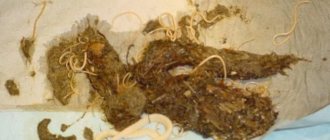Pugs are wonderful pets for the home, capable of becoming true friends for their owners and making friends even with cats.
However, an unpleasant feature of this breed is frequent allergic reactions. Almost every pug owner has encountered this disease. That is why it is so important for owners of dogs of this breed to know what can trigger an allergy in an animal, its symptoms and treatment regimens.
How do allergies manifest in dogs?
We all - both humans and animals - have our own immunity, that is, the body’s ability to resist the effects of harmful substances on it, but sometimes this well-functioning mechanism malfunctions, and the immune system begins to overreact to certain irritants.
If these substances enter the body repeatedly, the body reacts with an inflammatory process, as well as a violation of the structure of blood vessels and other internal pathologies. Of course, we are unlikely to notice all these internal changes with our eyes, however, fortunately, allergies also have a number of quite striking external manifestations. The most common manifestation of allergies in dogs is all kinds of dermatological disorders: rashes, peeling of the skin, partial or even complete hair loss, redness, itching (1). Moreover, most often these phenomena are noticeable on the fingers, stomach, muzzle, ears and under the arms, in a word, where the fur is the shortest and the skin is always better visible. Often, the dog constantly itches and even gnaws off fur, injuring itself, and becomes nervous due to the endless itching.
Allergic reactions also include swelling, watery eyes, nasal discharge, and wetting under the arms.
The cause of allergies can be the natural predisposition of a particular breed or heredity in an individual dog. Thus, breeds such as Labrador Retriever, Springer Spaniel, West Highland White Terrier, Dalmatian, and Shar Pei are prone to allergies. Of course, this does not mean that, for example, one hundred percent of Labradors will be allergic, but the incidence rate in the above breeds is higher. Stress also significantly increases the likelihood of developing allergies. If a dog is constantly in a nervous environment or has suffered some kind of severe shock (for example, a change of owner), then it may develop an allergy.
Allergies can be triggered by poor ecology, hormones found in chicken meat and milk, and dry food (2).
In a word, allergies in dogs not only happen, but are also a fairly common disease.
Treatment of animal allergies
If during the examination an accurate diagnosis was established - an allergy to animal fur - the pet will have to be disposed of. Unfortunately, limiting contact with the animal will not solve the problem. If the furry pet remains in the house, microscopic allergenic particles will continue to fly in the air, and it will not be possible to completely protect yourself from them, even by doing daily wet cleaning and ventilating the room3.
To relieve allergies and their symptoms, doctors advise taking the following types of medications:
- Cetrin® – tablets that block histamine H1 receptors. While taking them, swelling disappears, runny nose and lacrimation stop. The drug acts almost instantly. To get the effect, it is enough to take only one tablet. The drug has a cumulative effect and is not addictive. You can take Cetrin® for a long period of time5.
- Triamcinolone and Budesonide are corticosteroids for topical use in the form of a spray. Soothe itching and relieve redness of the skin.
- Levacabasin and Allergodil are hormonal nasal drops. They block H1 receptors, eliminate the symptoms of allergic rhinitis, relieve itching and swelling of the nasal mucosa.
To learn more about how to deal with animal allergies, you should consult an allergist. All of the above remedies only relieve symptoms, temporarily improving the condition, but do not treat the cause of the disease. Do not self-medicate - temporary relief of the condition will not bring the desired effect, but will only worsen the situation.
Allergies cannot be eliminated forever. But long-term remission can be achieved by using specific immunotherapy SIT. Treatment is carried out in a course, under the supervision of a doctor: the patient is given subcutaneous injections of purified allergen in microdoses for 6 months. During this time, the immune system “gets used” to the contents of the injections and stops responding to the allergen. The effect after such treatment lasts for several years, after which, if necessary, the course of injections is resumed6.
Bibliography
- Allergology and immunology: national guide / ed. R. M. Khaitova, N. I. Ilina. - M.: GEOTAR-Media, 2009. - 656 p.
- Cepel E., Haney M., Miskhakh S., Snowden. Fundamentals of clinical immunology / Translation from English. 5th ed. - M.: GEOTAR-Media, 2008. - 416 p.
- Allergy to pets: features of diagnosis and treatment [Electronic resource]. – Access mode: https://www.lvrach.ru. – (Last access date: 10/1/17).
- Macharadze D. Sh., Sepiashvili R. I. Pilot screening of allergic diseases during clinical examination of Moscow schoolchildren // Allergology and Immunology, 2007, vol. 8. p. 187–190.
- Instructions for use of the medicinal product for medical use Cetrin®. – Registration number: P N013283/01.
- Allergology. Clinical recommendations developed by the RAACI Working Group / ed. R. M. Khaitova. – M.: Farmarus Print Media, 2013. – p. 126 p.
Types of allergies
Just like in humans, allergies in dogs can come in different types.
Food allergies. That is, intolerance to certain products, or more precisely, to the active substances they contain. They must be completely excluded from the dog’s diet (3).
Allergy to flea saliva. Like all other blood-sucking insects, a flea, when biting a dog, releases a special secretion (saliva) into the blood, which contains anticoagulants, that is, substances that prevent blood clotting. Often this saliva causes an allergic reaction (2). This is why it is so important to regularly treat your pet against ectoparasites.
Allergy to substances coming from the external environment. This includes both chemical irritants (paint, dust, etc.) and the effects of all kinds of plants. Having previously identified what exactly causes a negative reaction in the dog’s body, it is necessary to stop all contacts of the animal with the allergen.
The most common diseases of pug dogs
A predisposition to a disease does not mean that every pug will have it. Closely monitor your pet's condition and activity. If you see something wrong in your pet's behavior, it is best to contact a veterinarian.
The following diseases are not common in the breed, but they can occur:
- Encephalitis. An inflammatory disease of the brain that is unique to pugs. Medical researchers don't know why pugs get this condition; there is no way to test it or treat it
- Epilepsy. It is often inherited and can cause mild to severe seizures. Seizures may involve unusual behavior, such as running frantically as if being chased, staggering, or hiding. It is important to remember that seizures can be caused not only by epilepsy, but also by many other things, such as metabolic disorders, brain infections, tumors, exposure to poisons, severe head injuries and much more.
- Corneal ulcers. The pug's eyes are large and bulging, so they are damaged and can develop corneal ulcers. If the eyes appear red and watery, contact your veterinarian immediately. Corneal ulcers usually respond well to treatment, but if left untreated, they can cause blindness or even rupture of the eye.
- Keratoconjunctivitis Sikka, or dry eye, occurs when the eyes do not produce enough moisture to stay moist. Can be controlled with medications and special care. This eye condition requires lifelong therapy and care.
- Eye problems.
- Allergy. Allergies are a common disease in dogs. There are three main types of allergies: food allergies, which are treated by eliminating certain foods from the dog's diet; contact allergies, which are caused by reactions to substances such as bedding, fleas, dog shampoos and other chemicals; and inhalant allergies, which are caused by airborne allergens such as pollen, dust and mold. Treatment varies depending on the cause and may include dietary restrictions, medications, and environmental changes.
- Demodecosis. Caused by the demodex mite, which a mother dog passes to her puppies in the first few days of life. The tick cannot be transmitted to people or other dogs; only from mother to puppies. Demodex mites live in hair follicles and usually do not cause problems, but if your Shar Pei has a weakened or compromised immune system, he may develop demodicosis. In its localized form, patches of red, scaly, balding skin appear on the head, neck and forelimbs.
- Hip dysplasia: This disease affects both small and large breeds, including pugs. Many factors, including genetics, environment and diet, are thought to contribute to this hip deformity. Affected Pugs are usually able to lead normal, healthy lives with proper veterinary attention.
- Legg-Calvé-Perthes disease. This is another disease associated with the hip joint. Many ornamental breeds are susceptible to this condition. When your Japanese Chin's femur becomes smaller and begins to disintegrate. Typically, the first signs of leg-pertus, lameness, and leg muscle atrophy appear when puppies are 4 to 6 months old. This condition can be corrected with surgery.
- Knee dislocation. This is when the knee joint (often the back leg) slips inward, causing pain.
- Sensitivity to vaccination. Monitor your pug closely for a few hours after vaccination and call your veterinarian if you notice anything unusual.
- A skin infection caused by folds in the skin that are rubbed or exposed to moisture. This is more common in breeds that have folds in their skin. Signs of folded dermatitis include redness, sores and odor, and the dog can be affected on the tail, face, lips and other parts of the body. Treatment for fold dermatitis varies depending on the area affected, but may include surgical removal of the folds or tail amputation in the case of tail fold dermatitis. The best treatment is to properly care for your dog's coat to prevent disease.
Symptoms
As a matter of fact, the most striking symptoms include the above-mentioned external manifestations of allergies. However, this disease can also masquerade as other diseases; in this case, the dog owner, even if he is a veterinarian, is unlikely to be able to confidently make the correct diagnosis solely based on external signs. These include vomiting, upset stomach, lethargy, and fever (above 39.5 °C). That is why it is so important not to neglect all these manifestations and contact a specialist in time, because an allergy that is harmless at first can intensify and lead to serious consequences, including anaphylactic shock.
As for the symptoms that can be identified using tests in the clinic, we can talk about the body’s specific responses to the introduction of small doses of potential allergens.
How and what to feed a pug
Pugs should be fed twice a day with up to 1/2 cup of dry dog food at each meal. The amount needed depends on the dog's size, activity level, age and other factors, which will change throughout your dog's life.
You should limit your pug's diet and not give human food as treats. Pugs love to eat and can easily become overweight or obese, which can shorten their lifespan and contribute to the development of many diseases.
Be sure to monitor your pet's weight and discuss his diet with your veterinarian for recommendations on keeping your dog healthy.
Diagnostics
Unless you are a veterinarian, do not try to diagnose it yourself. The fact is that there are a huge number of diseases with exactly the same manifestations, and without special laboratory tests it is impossible to establish the exact cause of the disease. For example, an upset stomach can occur due to both food poisoning and allergies.
That is why, if you notice one or more of the above symptoms, it is better to immediately contact your veterinarian. The clinic will carry out the full range of necessary tests: tests will be taken, in case of dermatological manifestations - skin scraping, checking for the presence of fleas, as well as tests to identify the allergen.
Based on the data obtained, the veterinarian will be able to say what exactly caused the allergic reaction so that the dog can be completely eliminated from contact with a substance harmful to it. If there is a food allergy, a special diet is drawn up that excludes foods containing the allergen.
First aid for an animal
Before being examined by a veterinarian, the dog must be given first aid. If allergy symptoms are detected, the pet is first given an injection of Suprastin. The best place for injection is the hind thigh or withers.
Medicines based on calcium chloride will help reduce itching. Since these tablets have a bitter taste, they should be crushed and dissolved in warm, sweetened water. If there are purulent foci on the skin, they need to be treated with antibacterial agents. Bathing in water with the addition of decoctions of medicinal plants (for example, string) is also beneficial for the animal.
Hydrocortisone effectively relieves itching. If the terrier refuses to take the drug in tablets, you can prepare a spray. To do this, mix 4 tablets of the medicine, 350 g of distilled water, 100 g of alcohol and 50 g of glycerin. Pour the mixture into a spray bottle and shake.
Treatment methods
Treatment of allergies in dogs is carried out with medication and by eliminating contact with the allergen. Once the veterinarian determines the cause of the disease, he will prescribe treatment. Typically, antihistamines are given to your dog in the form of tablets or injections.
At first, while the allergen has not yet been identified, the dog may be prescribed medications such as Tavegil, Diazolin or Diphenhydramine - these are universal drugs that work for all forms of allergies. Diprazine, as well as anti-inflammatory ointments, cope well with skin itching.
If it comes to anaphylactic shock (and it also happens in dogs), expressed in severe swelling, vomiting, heart palpitations and even loss of consciousness, then it is necessary to immediately call a veterinarian, because in this case, if urgent assistance is not provided in time, the consequences may be severe, even fatal.
Therapeutic tactics
The first and most important thing that the owner of a four-legged friend needs to remember at this stage: treating the animal without prior consultation and examination by a veterinarian is strictly prohibited. Self-medication can cause irreparable harm to a four-legged patient. A diagnosis made “by eye”, such as an allergy to protein, should also alert the owner. Without additional testing and appropriate tests, even a reputable dog doctor will not risk announcing the verdict. Until you get the results of allergy tests, it’s like pointing your finger at the sky. Correct diagnosis is half of successful treatment.
Contact with an allergen. As long as the four-legged patient is in contact with the allergen, nothing in his health will change for the better. It will only get worse. All diagnostic procedures are aimed at finding the provocateur of the body’s violent reaction and neutralizing it.
Symptomatic treatment. Itching, swelling, peeling of the skin, purulent eczema - all these manifestations of the disease require targeted treatment. Therefore, the doctor prescribes ointments and tablets that help improve the patient’s condition.
It is important to understand that symptomatic treatment will only give a temporary result if the provocateur of the disease is not identified.
Analyzes
Dog lovers often feel that veterinarians are leading them by the nose. Unscrupulous doctors really use love for an animal as a way to siphon money from the owner
Therefore, it is important to know what tests the doctor can prescribe in this situation. First of all, to exclude food allergies, the four-legged patient is put on a strict diet
Its duration, if necessary, can reach two months.
- Crops. They can be very different. Some cultures can determine a dog's sensitivity to specific antibiotics. With the help of others, the presence of fungi or bacteria that may be potential causative agents of an antibody response is detected or refuted.
- Trichoscopy. A study aimed at examining the quality and quantity of wool and skin allows us to exclude the fungal component.
- Scrapings. Using this simple analysis, the doctor checks whether the patient is sick with parasitic diseases, or whether the dog is completely healthy in this regard.
- Cytology. Sometimes, to confirm or refute a specific diagnosis, the veterinarian checks for the presence or absence of inflammatory processes in the animal’s body.
Diet
Competent feeding is not only the principle of treatment, but also the principle of diagnosing the disease. It is quite possible that your pet suffers from a food allergy, which is characterized by gradual development and slow progress. Correcting the diet will help determine what type of protein your pet’s body reacts so violently to.
- "Substitution of concepts". Suppose the dog's diet was based on chicken or lean pork. The owner’s task is to completely remove the usual meat from the menu, replacing it with other, less allergenic products. For example, beef or turkey. They are usually included in dietary feeds.
- Hypoallergenic food. If the method of replacing one protein with another does not bring the expected result, the four-legged patient is transferred to special dry food - ready-made dietary food.
- Elimination of potential allergens. If preference is still given to natural food, then you need to feed the dog as much as possible dietary products. No salted, smoked or fried foods. Not an ounce of sweets, sausages or sausages. Do not forget that even a therapeutic diet must be balanced.
Urgent Care
There are times when an allergy takes a dog and its owner by surprise. A striking example of this is angioedema, which occurs due to a wasp sting. Symptoms appear instantly, forcing the owner to act immediately - without waiting for the doctor to arrive. The table will tell you what to do in such cases.
Table - First aid options
| State | Method of providing emergency care |
| Severe allergies | — Suprastin injection; - injections of "Adrenaline" and "Tavegil" |
| Anaphylactic shock | — Dexamethasone injection; - urgent visit to the veterinarian |
The listed drugs are a mandatory part of a home veterinary first aid kit.
How to treat allergies in dogs at home
Many people wonder: how to treat allergies in dogs? It is worth understanding that it is impossible to get rid of the disease completely at home. All the owner can do is, firstly, to urgently relieve the symptoms if they have become severe, eliminate the dog’s contact with the allergen (remove fleas, remove food from the diet that could potentially cause a similar reaction), and also try to reduce Minimize unpleasant manifestations of allergies. To relieve skin itching, healing and antipruritic agents are used, but if the dog has increased lacrimation and nasal discharge, then special ointments and drops, which are sold in any veterinary pharmacy, are suitable.
In a severe case, the dog may experience swelling, which must be relieved with medication, but do not try to give the animal human medications unless you know for sure that this is not contraindicated for him - the fact is that not all drugs that are widely used in human medicine are are suitable for dogs, and experimenting with medications can only make things worse.
After relieving your dog's life-threatening symptoms, be sure to take him to a veterinarian, who will find out what caused the allergic reaction and prescribe treatment.
In the ears
In some cases, an allergy in a pug can manifest itself in the form of severe itching in the ears. Most often this is due to a reaction to fleas and ticks, which can penetrate very deeply into the dog's ears.
If you cannot remove them yourself using ear sticks, seek help from a doctor.
Ignoring such symptoms can lead to the death of the animal. Important! The main symptom of ear allergies is the appearance of many small pimples.
The following can cause ear allergies in pugs:
- Food;
- hygiene products;
- medicines and vitamins;
- insect bites.
If suspected allergens are excluded and the symptoms do not disappear, otitis may be suspected. This diagnosis is more likely if the following symptoms are added to the itching:
- heat;
- purulent discharge from the ears;
- soreness and swelling of the ear.
To minimize the risk of serious complications, treatment should begin as early as possible. Incorrectly chosen treatment can lead to complete deafness of the dog, so at the first signs of illness, take your dog to the doctor.
Preventing allergies in dogs at home
In order for your four-legged friend to live a long and healthy life and delight you with his company for many years, it is necessary to prevent allergies in your dog. Of course, as we have already found out, some animals have a congenital predisposition to this disease, but we are able to minimize both the negative manifestations of this reaction and the very fact of its occurrence. Of course, it is impossible to foresee everything in the world, because a dog rarely lives in a completely ecologically clean environment (and even there there may be allergy-causing plants or insects), and as a rule, this is a city with its exhaust gases, concrete and asphalt. But still, something can be done.
Firstly, you should never neglect treating your dog for parasites – both external (fleas, ticks) and internal (helminths), because they all release their waste products into the dog’s body. Secondly, if you have a pet in your home, it is better to select its diet together with a veterinarian. And thirdly, try to make your dog always feel loved and confident, because, as we have already found out, constant stress greatly increases the likelihood of allergies.
Reason 2. Night snoring throughout the apartment, like from a healthy man with a hangover
Since pugs do not have a normally formed nose and have problems with the respiratory tract - this is their genetic norm, they snore terribly loudly, deeply and piercingly. It's impossible to fall asleep. I have to move him from my bed to Cooper’s place in the hallway and close all the doors. It’s good if the apartment has a comfortable temperature, that’s when it’s not hot. If it’s hot, for example due to hot summer weather, and you don’t have air conditioning, Cooper snores not through his nose, but through his entire mouth, lying on his side to somehow cool down. The volume of snoring increases two to three times. Sweet dreams and good night!
Popular questions and answers
Reshat Kurtmalaev, a veterinarian at the Simferopol Laskava clinic, answered our questions about allergies in dogs
Is it true that all white dogs are allergic?
You need to understand that there are just white animals, and there are albinos, and they often have not only allergies, but also other health problems. In animals whose coat color is simply determined by their breed, allergies do not occur as often. But still, owners of white dogs should pay attention to their diet, because after all, the likelihood of this disease occurring in them is somewhat higher.
What foods most often cause allergies in dogs?
An allergic reaction to chicken always occurs more often - this is the most common option. After all, animals love chicken very much - it is softer to eat and simply tastier than other products. Therefore, it is better not to give chicken to dogs at all. We recommend feeding dogs lean boiled beef. Raw meat can be given only if you are absolutely sure that there are no parasite larvae in this meat.
Why does chicken so often cause allergies in dogs?
As a rule, chicken meat contains a lot of different chemicals, hormones and other harmful substances that cause the dog’s body to malfunction.
Is it possible to treat a dog for allergies yourself?
It's best to see a veterinarian because treating your dog yourself may relieve the symptoms, but it won't end the disease, and the allergic reaction may end up being many times worse than it was initially.
How dangerous are allergies in dogs?
They, like people, experience such a manifestation as Quincke's edema, which causes suffocation.
To prevent this from happening, it is better to consult a veterinarian in time, who will find out what protein the dog is allergic to in order to prevent contact with it. And if it is impossible to exclude (for example, a neighbor has planted an allergenic plant, and he does not want to remove it), then prescribe treatment. Sources
1. Ivanova M.V., Skubko O.R. Etiopathogenesis of allergic food dermatitis in dogs // Electronic scientific and methodological journal of Omsk State Agrarian University, 2020 https://cyberleninka.ru/article/n/etiopathogenez-allergicheskih-pischevyh-dermatitov-u-sobak
2. Mitrofanova E.V. The main causes of food allergies in domestic animals in urbanized areas // Eurasian Union of Scientists, 2016 https://cyberleninka.ru/article/n/osnovnye-prichiny-vozniknoveniya-pischevyh-allergiy-domashnih-zhivotnyh-v-usloviyah-urbanizirovannyh- territory
3. Mueller Ralph S. How to find an allergen - diagnosis of atopic dermatitis // VetPharma, 2016 https://cyberleninka.ru/article/n/kak-nayti-allergen-diagnostika-atopicheskogo-dermatita
Atopic dermatitis
Symptoms:
- incessant itching, the dog is constantly scratching;
- skin damage on the face, on the fingers, tears, cracks, inflammation, formation of boils;
- formation of focal lichenification after scratching;
- dry skin;
- instant reaction of the body to the allergen;
- external form of otitis;
- external manifestations of staphylococcus.
The complexity of the disease is determined by the duration of exacerbations and the size of the affected skin area:
- in mild cases, symptoms appear a maximum of 2 times a year for 2-3 weeks;
- Moderate dermatitis is characterized by manifestations 3-4 times a year with a total duration of 1-2 months;
- in severe cases, remission is completely absent or its duration is a maximum of 1 month.
Difference in affected area:
- with a mild degree, small single spots appear;
- medium is characterized by numerous skin irritations;
- the severe degree is characterized by a large number of merging lesions, gradually turning into erythroderma.
Treatment
Treating atopic dermatitis requires a lot of effort and patience. In most examples, this disease manifests itself in animals throughout their lives.
To make your animal's allergies less pronounced, you need to buy him special food, provide fresh air into the room and control the humidity level. You will also need special ultraviolet emitters.
Providing the right conditions to eliminate atopic dermatitis in dogs requires considerable expense, so many owners simply leave everything as it is.
Treatment requires regular use of antihistamines. You need to buy only types of feed that are guaranteed to be safe. The room in which the animal is kept must always be clean.
Only 15-30% of animals show a positive reaction to antihistamines. Cyclosporine is considered the most effective drug, helping to eliminate allergies in its various manifestations.
To teach the immune system to fight allergens, their components are introduced in very small doses into the animal’s body. This method is called hyposensitization. However, this method of eliminating allergies requires relatively considerable costs.
Non-steroidal drugs that relieve inflammation also help with atopic dermatitis. It is not recommended to use folk remedies to treat such a disease. Such methods will not bring the desired results and can only harm the animal.
Expert advice
As soon as all signs of the disease are stopped, antibacterial and antifungal agents are prescribed. In this case, you can use shampoos specially made for such purposes. To improve the functioning of the immune system, a special diet is developed for the animal.
During treatment the following medications are prescribed:
- Toloxtaton;
- Amitriptyline;
- Trimipramine;
- Peritol;
- Suprastin;
- Benadryl;
- Prednisolone;
- Dexamesaton.
Doctors recommend providing a sick pet with proper care; the dog needs to be constantly bathed and combed. Treatment of the skin against parasites should be carried out in accordance with the doctor’s recommendations. It is not advisable to overfeed your dog or give it foods that people eat.
Constant movement is beneficial for the animal, so frequent active walks on the site are recommended.











